Dictionary skills activities
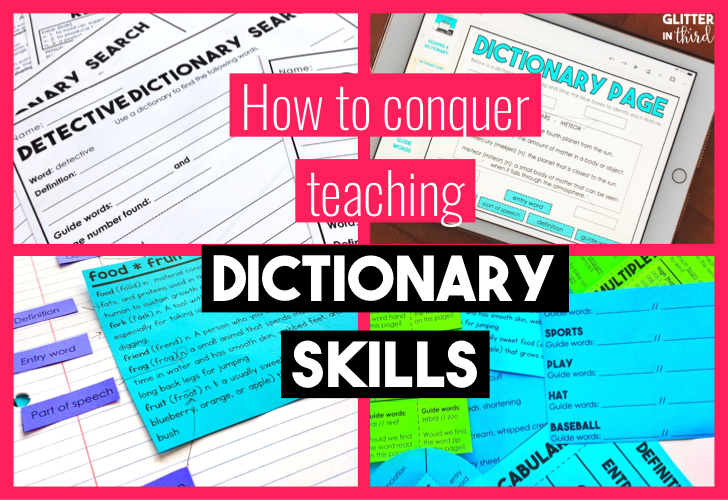
Do you teach dictionary skills? Does the thought of teaching dictionary skills like guide words, multiple meanings, and alphabetical order to students make you cringe and want to hide under your desk? It’s okay if you are nodding yes…. I used to feel this exact same way too!
This is the toughest ELA skill all year that my students work on. So you know what? Start early! Practice, practice, practice whenever you are able to.
I am going to break down the EASIEST way to teach dictionary skills in the best possible order.
Don’t forget to scroll to the bottom of the post to download your FREE dictionary search that you can start using immediately in your classroom!
There are five parts that students need to understand to be fluent in dictionary skills:
- Parts of a dictionary page
- Real-life searching a dictionary
Below, I will be discussing each of these five parts and how you can practice with your students to allow mastery in this skill.
I put the dictionary skills in order that they are best taught!
Step 1: Parts of a dictionary entry
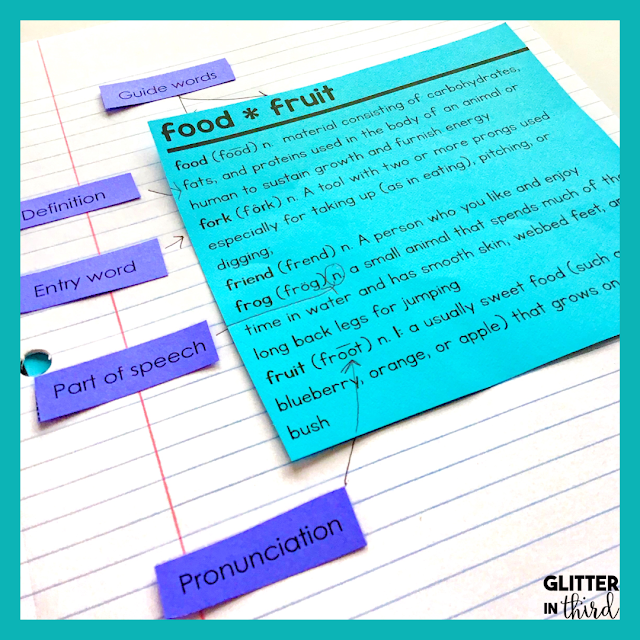
This is where I would start my introduction to teaching dictionary skills. Why? Because in order for students to master each skill, they need to understand the vocabulary involved.
Students need to not only know what each vocabulary word means, but they also need to know where on the dictionary page they can locate it.
Important dictionary skills vocabulary includes:
If you are interested, my
Dictionary Skills for Google Classroom and
Dictionary Skills interactive notebook has a terrific introductory section. It involves students labeling a dictionary page, and also goes through each vocabulary word and definition. This is a
massive time-saver that I would highly recommend to you! Because let’s be honest…. teachers don’t have enough time as it is!
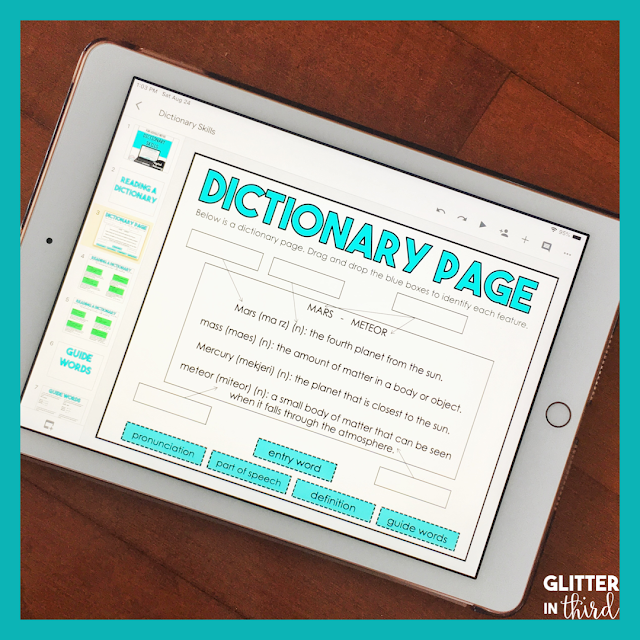
Step 2: Alphabetical order worksheets & activities
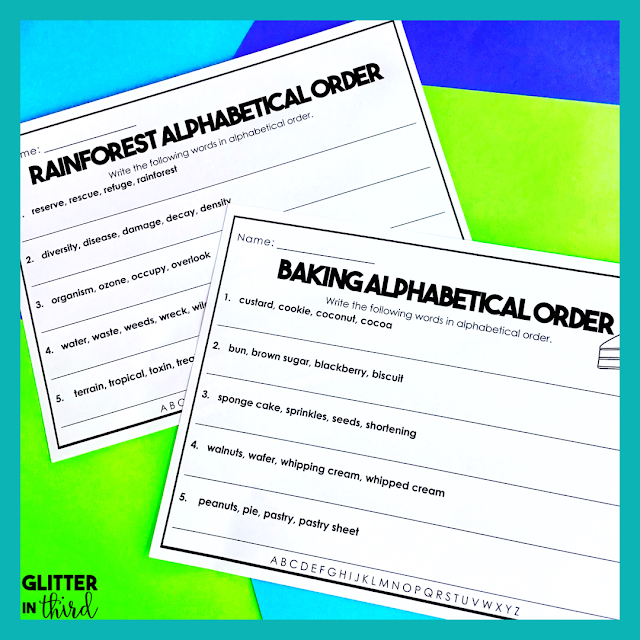
Students need to put a
group of words into ABC order. This is a TOUGH TOUGH TOUGH skill.
My tip? Write down the entire alphabet on the board, and have students write it on their paper as well. Then, follow my steps below.
Step 1:
Line up the words.
For example, let’s use the set of words fox, flower, faint, and fail.
fox
flower
fainting
faint
fail
Step 2:
Group like words together.
Step 3:
Begin crossing off letters from the left hand side that are similar.
Step 4:
Hmmmm… we have come to an “a”, “o,” and “l.” Looking at the alphabet strip, which of these letters comes first in the alphabet? Last in the alphabet? Move words accordingly.
Step 5:
Now we will focus on all the “fa” words since we took care of “flower” and fox.” Does ‘n’ or ‘l’ come first? Keep crossing off letters from the left hand side. Move words accordingly.
Step 6:
Okay….. now we have “fainting” and “faint.” Which comes first? I always tell my students: Blanks come before anything else. That means that “faint” comes before “fainting.”
Woohoo! We did it! It may seem like a lot of steps, but it works so well when kids are still learning. They will get quicker and quicker at it in no time, and eventually will no longer need to write it out like that.
Step 3: Guide words practice
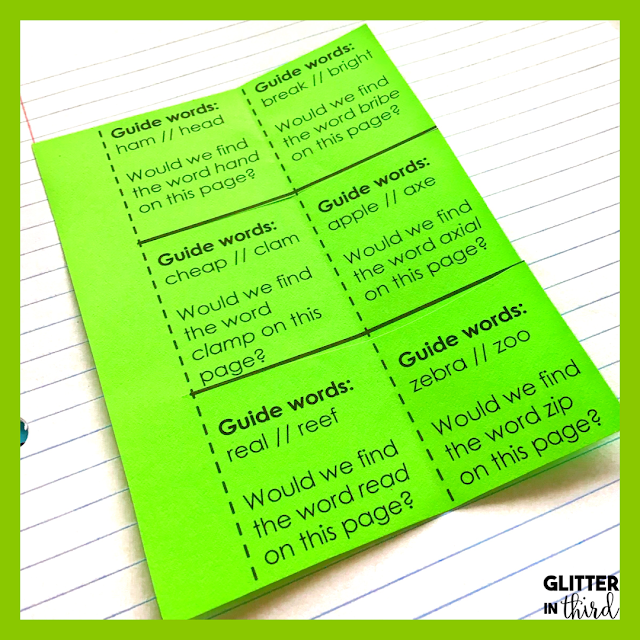
Students need to look at two guide words (words on the top of a dictionary page that indicate the first and last word on a dictionary page). Then, they need to find what words would come on that page.
Without a doubt, this is the toughest dictionary skill that students will do. Here’s how I teach this:
Step 1:
Line up the words.
For example, let’s use the guide words “take” and “Tasmanian.” Write the words down.
take
Tasmanian
Step 2:
Place the word that the question is asking in between. (for example, is “tattoo” on the same page as guide words “take” and “Tasmanian”?)
take
tattoo
Tasmanian
Step 3:
Begin crossing off letters from the left hand side that are similar.
take
tattoo
Tasmanian
Step 4:
Stop! There’s a K, T, then S. Are these in alphabetical order? No? This means that “tattoo” would NOT be on the same page as these guide words!
After kids get the hang of this method, it becomes more second-nature to them and they usually stop writing it out each time. However, this is a fabulous beginning method to learn if a certain words falls between two guide words!
Step 4: Multiple meaning words worksheets & activities
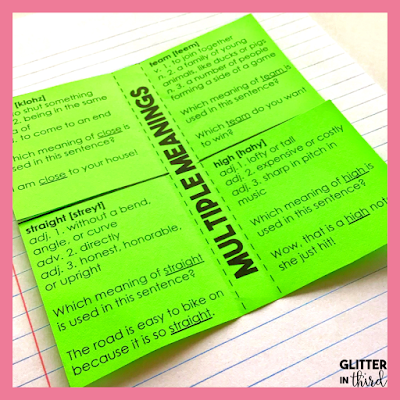
What are multiple meanings? When you look a word up in the dictionary, there are lots of different definitions. Sometimes the definitions are similar… and sometimes not so much. A word can mean a verb, noun, adjective, and adverb! Students need to use their context clues skills to figure out which definition works best for the word they are looking up.
To teach multiple meanings, give students a sentence with a specific underlined word. Have them look the word up in the dictionary, and write which definition is correct.
Students may find it challenging to know which entry is correct, especially for definitions that are very similar. Encourage students to look at the part of speech to discover which makes the most sense for the word in their sentence.
Step 5: Dictionary activities

Can students master each of the other four skills? That’s awesome! But now, it’s time to put all those skills together by using a real-life dictionary.
Dictionary searches are very easy to create for students, yet great practice putting their alphabetical order and guide words information together.
Not sure what to do? It’s simple! Simply give students a list of words to look up. I love doing this as a literacy center. For third-graders, I suggest 3-4 words for a 15-20 minute center.
I always ask the student to write the definition to give them practice with understanding entry words, as well as identifying the guide word and page number. Why page number? It helps ensure that they aren’t skipping the researching step and are actually looking the entry word up.
Want a free dictionary search?
Want to try out a dictionary search during your ELA block?
I have you covered!
Pin for later?








